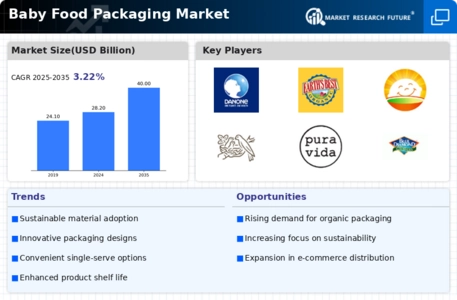Top Industry Leaders in the Baby Food Packaging Market

The global baby food packaging market is a dynamic arena defined by intense competition and constant innovation. With parents prioritizing convenience, safety, and environmental consciousness, players in this niche market are adopting strategic tactics to capture market share and cater to evolving consumer demands.
Strategies Shaping the Landscape:
-
Material Innovation: Sustainable and eco-friendly options like bioplastics, recycled paperboard, and compostable pouches are gaining traction, with established players like Amcor and Sonoco leading the charge. This aligns with parents' growing preference for responsible packaging solutions. -
Functional Packaging: Pouches with easy-grip features, resealable closures, and spill-proof mechanisms are enhancing convenience for parents juggling busy schedules. Brands like DoGood and Nuby are pioneering designs that prioritize mess-free mealtimes. -
Digital Integration: QR codes printed on packaging offer access to nutritional information, recipes, and even augmented reality experiences, engaging parents and building brand loyalty. Gerber's recent collaboration with SmARt Tags exemplifies this trend. -
Targeted Segmentation: Recognizing diverse needs, companies are focusing on specific niches like organic, allergy-friendly, and culturally-specific baby food packaging. The recent launch of Plum Organics' line in culturally relevant designs for Asian and Hispanic families highlights this strategy. -
Mergers and Acquisitions: Consolidation through acquisitions offers established players opportunities to expand their reach and acquire new technologies. Silgan Holdings' acquisition of Gateway Plastics in September 2021 is a prime example.
Factors Influencing Market Share:
-
Brand Reputation: Established brands like Heinz and Nestlé wield significant influence, while smaller organic and niche players rely on differentiation through unique value propositions. -
Pricing: Price wars are prevalent, particularly in the mass market segment, with private label brands offering budget-friendly alternatives. Differentiation based on functionality and sustainability offers premium players an edge. -
Distribution Channels: Supermarket giants hold significant sway, but online retailers like Amazon are gaining ground, offering direct-to-consumer sales and subscription models. Diversification across channels is crucial for success. -
Regulatory Compliance: Stringent regulations regarding food safety and material composition dictate production processes and influence consumer choices. Adherence and transparent communication on these aspects build trust.
List of Key Players in the Baby Food Packaging Market:
- Gerber Packaging
- Heinz Baby Food
- Nestle S.A.
- Piramal Glass
- Amcor
- AptarGroup
- Ball Corporation
- Owens-Illinois, Inc.
- Tetra Pak International S.A.
- Berlin Packaging
Recent Developments:
September 2021: HiPP has utilized Aptar Food and Beverage's Neo closure solution for its recent infant formula packaging. The tamper-evident closure solution includes a 127mm-wide lid and a scoop. It makes an audible 'click' sound to allow the package to be fully locked.
August 2021: Heinz declared an easily recyclable baby food pouch. The products are made purely from polypropylene and have been considered by the On-Pack Recycling Label. This aligns with the company's mission to remove plastic where possible and to make 100 percent of its packaging reusable, recyclable, or compostable by 2025.
July 2023: Gerber, the largest baby food company in the United States, announced that it would be introducing new packaging for its products that is made from recycled materials. This is part of Gerber's commitment to sustainability.
August 2023: Plum Organics, a leading manufacturer of organic baby food, announced that it would be launching a new line of baby food that is packaged in recyclable pouches. This is a response to growing consumer demand for more sustainable packaging options.
In March 2020 Nestle introduced the first-ever mono material pouch for baby foods that is designed to be recycled in the future. Through Gerber's national recycling program with TerraCycle, this product will be recyclable by 100%.
In June 2021, Kraft-Heinz owned Italian baby food company Plasmon brought back its “Squeezer and Taste” line but now in fully recyclable pack. The Plasmon snack pack includes hundred percent fruit especially suited for kids.
In November 2022, Plum Organics revealed their new packaging look across the entire range of the whole portfolio of nutritiously packed pouches and snacks aimed at fostering taste expansion in infants and toddlers who are selective about their meals; it helps make the customers feel comfortable about what their kids eat. This is a full redesign of packaging by Plum Organics, which aims to foster baby and toddler palate expansion.
In April 2022, Organic baby foods company Little Spoon will be completely rebranding its product labels to create a more impactful, cohesive look across its range of products and work better within the D2C environment. Recently, Little Spoon Organic expanded its product line to include smoothies, toddler and kids' meals, vitamin boosters and remedies.

